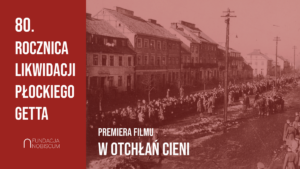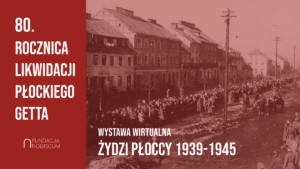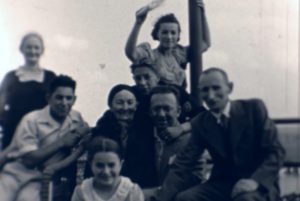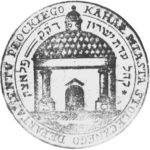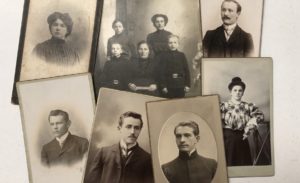The cemetery at Mickiewicza Street was founded in 1845. The last known burial on it took place in 1968. During the Second World War, the Germans devastated the area of the cemetery, and the matzevas were used to construct pavements and build stairs leading from the Dominican Hill to the Vistula bank. On February 22, 1945, the Jewish Committee was established, which in the autumn of 1946 organized an exhumation of the bodies of the Płock Jews murdered in the Imielnica ravine. The corpses were moved to the Jewish cemetery at Mickiewicza Street. On October 23, 1949, the unveiling of the monument commemorating the Jews murdered during the war took place, designed by architect engineer Arie Lejb Perelmuter. In 1967, the monument was destroyed. In the same year, the construction of a new monument began, according to the design of the artist Lucjan Kot. Near the monument, on the wall called the Wailing Wall, fragments of matzevot from the old and the new cemetery were placed. On the area of 3.2 ha, about 10 tombstones have been preserved, including Szyja Buch – a well-known Jewish activist, son of Abram Mosze and Chana Gitla, who after the war was a member of the Jewish Committee, and in 1949 one of the co-founders of the Gerszon Dua Clothing Workshop Cooperative in Płock, based in the former synagogue at Kwiatka 7 Street, and Alfred Blay – before the war, the owner of the cloth shop at Grodzka Street, since 1946 the chairman of the Jewish Committee in Płock.
Recent Posts
- Borys Kowadło
- Icek Bernsztajn
- Yaakov Guterman
- Alfred Blay
- Support the 7th year of JewishPlock.eu initiative!
- Pinkas Hakahal of Płock 1762-1818 in academic edition by Pnina Stern
- In the footsteps of Adam Neuman-Nowicki. Premiere of the guidebook in the autumn 2025
- 20th International Holocaust Remembrance Day
- The house at 64 Sienkiewicza Street in Płock in the register of historic monuments!
- Premiere of the documentary “Erasing Oblivion”
- 104th anniversary of the defense of Płock against the Bolshevik invasion
- “Adam and his Płock” – premiere of the book on 23 March
- 83rd anniversary of the deportation of Jews from the ghetto in Płock. Announcement of a new publication
- Kwiatka Street. The 6th guidebook by the Nobiscum Foundation to be published this year
- New permanent exhibition and the Memorial Wall in the Treblinka Museum
- International Holocaust Remembrance Day. Light of Remembrance in the windows of Płock
- 150th birth anniversary of Józef Kwiatek
- 80th anniversary of the Sobibór Uprising
- Exhibition “Szenwic. The story of a family” now available online!
- The guidebook “In the footsteps of Jewish artists from Płock” available from September 5
- Jewish women of Płock in the face of the Polish-Bolshevik war. New publication of the Nobiscum Foundation
- Szenwic. The story of a family – an exhibition by the Nobiscum Foundation starts 2 September
- People from Płock and the revolt in Treblinka. Our film “The last path of their lives” available online
- Premiere of the film “The last path of their lives. People of Płock in the Uprising in Treblinka”
- Appeal of the Nobiscum Foundation regarding the matzevot from the Park on the Hill in Płock
- We received the “Preserving Memory” award
- We’ve joined the Network of the Forum for Dialogue!
- The walls of this small building witnessed great love and paralyzing fear. The municipality of Płock must save it.
- Beniamin Lejb Sztucki
- Film project “The last path of their lives. People of Płock in the Uprising in Treblinka”.
- 80th anniversary of the outbreak of the Warsaw Ghetto Uprising. The Daffodils Campaign in Płock.
- Achavah. A series of workshops and meetings with the history and culture of Jews from Płock
- Beniamin Lejb Perelmuter
- Support the fifth year of JewishPlock.eu!
- 10 years ago the Museum of Mazovian Jews has been opened
- Symcha Guterman, Edward Flatau and Nachum Sokolow: our proposals for patrons of streets in Płock
- 82nd anniversary of the deportation of Jews from the ghetto in Płock
- Light of Remembrance in the windows of Płock. International Holocaust Remembrance Day
- Ada Holtzman
- The book “Rachmonim bnei rachmonim. Charity and philanthropy of Płock Jews” available from 14 November
- Fiszel Gerszon Nordenberg
- Online exhibition “Rachmonim bnei rachmonim. The charity and philanthropy of Płock Jews”
- Bolesław Norski-Nożyca
- New edition of the guidebook “In the footsteps of Płock Jews” available from 28 August
- 79th anniversary of the outbreak of the Treblinka Uprising. Heroes from Płock in the uprising
- Rachmonim bnei rachmonim. The charity and philanthropy of Płock Jews – online exhibition from 4 September
- 9 Kolegialna Street (Palace of the Flatau family)
- Cyrla (Czesława) Graubart
- Natan Graubart
- Chiel Bieżuński
- 25 Kwiatka Street – the Rabbi’s House
- The Holcenbecher family
- Ilana Szlachter and Bella Lerman
- Hanka Borensztejn
- Jadwiga Graubart
- Mira Mariensztras
- Ewa Guterman
- Eda (Estera) Zylbersztajn
- Ilonka Rappel
- Łucja Weinles and Irena Themerson-Miller
- Premiere of the film “Black skies. The fate of Płock Jews in the years 1941-1945”
- Jan Stanisław Mar
- 81st anniversary of the liquidation of the ghetto in Płock. Broken life. The fate of women of Płock during World War II and the Holocaust
- Chaskiel Szenwic
- 81st anniversary of the liquidation of the ghetto in Płock. Light of remembrance at the Jewish cemetery
- Roman Londyński
- 81st anniversary of the liquidation of the ghetto in Płock. Premiere of the film “Black skies. The fate of Płock Jews in the years 1941-1945”
- Records of the Rogozino commune
- Jerozolimska Street
- The most important Jew in the world. Nachum Sokołow in a series of podcasts and articles
- The film “Black skies” of the Nobiscum Foundation with funding of the Association of the Jewish Historical Institute of Poland
- Szmuel Penson
- Izrael Wolf Cynamon
- Polish schools in tribute to the American people in memory of the 150th anniversary of the independence of the United States
- Julian Stryjkowski
- Chana Sura Klejn
- Leon Kaufman
- Lejb Abrahamowicz Rakowski
- Juda Lejb Złotnik
- Chaskiel Lipszyc
- Jonasz Markus Złotnik
- Salomea Kempner
- The history of the Jewish cemeteries and the mikveh of Płock in the series “Płock within your reach”
- Ryfka Goldkind
- Abram Mojżesz Widawski
- Regina Ber
- The synagogues of Płock – first episode of the series “Płock within your reach”
- Artur Ber
- Gustaw Cyprys
- The Marienstras family
- Dalet. Remembrance in sound
- Premiere of the film “Into the abyss of shadows” and the exhibition “The Jews of Płock 1939-1945”
- Matias Marienstras
- The Medical Society of Płock
- Light of Remembrance in the windows of Płock
- Mieczysław Themerson
- Paweł Goldstein
- 80th anniversary of the liquidation of the Płock ghetto
- Józef Majer Kunig
- Wilhelm and Filip Lubelski
- Zygmunt Perkahl
- Dawid Wassercug
- Traces of the Jews of Płock – map prepared by students from Płock
- Cecylia Kempner
- Izydor Wasserman
- 48 Sienkiewicza Street – the factory of the Sarna family
- I am a Pole, I don’t care what the whole world thinks… – Adolf Adam Goldberg and his diaries
- 100th anniversary of the defense of Płock against the Bolshevik invasion
- Kwiatka Street
- The Celner family
- The Makabi Jewish Gymnastic and Sports Society
- The Nobiscum Foundation announces the guidebook “In the footsteps of the Jews of Mazovia”
- The Perelgryc family
- Feliks Tuszyński
- The Sadzawka family
- Jehuda Lejb Margolies
- Maurycy Markusfeld
- The Bieżuński family
- Maksymilian Eljowicz
- Roman Pakuła
error:
Ta strona korzysta z ciasteczek aby świadczyć usługi na najwyższym poziomie. Dalsze korzystanie ze strony oznacza, że zgadzasz się na ich użycie / This site uses cookies to provide high quality services. Further use of the site will mean that you're ok with this.OKPrywatność





